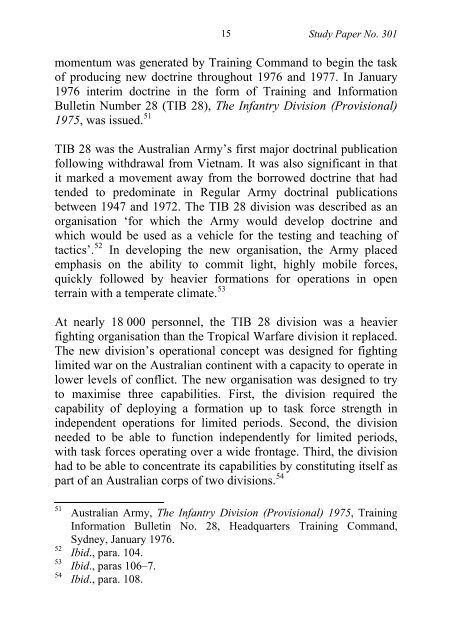Ibid - Australian Army
Ibid - Australian Army
Ibid - Australian Army
Create successful ePaper yourself
Turn your PDF publications into a flip-book with our unique Google optimized e-Paper software.
15<br />
Study Paper No. 301<br />
momentum was generated by Training Command to begin the task<br />
of producing new doctrine throughout 1976 and 1977. In January<br />
1976 interim doctrine in the form of Training and Information<br />
Bulletin Number 28 (TIB 28), The Infantry Division (Provisional)<br />
1975, was issued. 51<br />
TIB 28 was the <strong>Australian</strong> <strong>Army</strong>’s first major doctrinal publication<br />
following withdrawal from Vietnam. It was also significant in that<br />
it marked a movement away from the borrowed doctrine that had<br />
tended to predominate in Regular <strong>Army</strong> doctrinal publications<br />
between 1947 and 1972. The TIB 28 division was described as an<br />
organisation ‘for which the <strong>Army</strong> would develop doctrine and<br />
which would be used as a vehicle for the testing and teaching of<br />
tactics’. 52 In developing the new organisation, the <strong>Army</strong> placed<br />
emphasis on the ability to commit light, highly mobile forces,<br />
quickly followed by heavier formations for operations in open<br />
terrain with a temperate climate. 53<br />
At nearly 18 000 personnel, the TIB 28 division was a heavier<br />
fighting organisation than the Tropical Warfare division it replaced.<br />
The new division’s operational concept was designed for fighting<br />
limited war on the <strong>Australian</strong> continent with a capacity to operate in<br />
lower levels of conflict. The new organisation was designed to try<br />
to maximise three capabilities. First, the division required the<br />
capability of deploying a formation up to task force strength in<br />
independent operations for limited periods. Second, the division<br />
needed to be able to function independently for limited periods,<br />
with task forces operating over a wide frontage. Third, the division<br />
had to be able to concentrate its capabilities by constituting itself as<br />
part of an <strong>Australian</strong> corps of two divisions. 54<br />
51<br />
52<br />
53<br />
54<br />
<strong>Australian</strong> <strong>Army</strong>, The Infantry Division (Provisional) 1975, Training<br />
Information Bulletin No. 28, Headquarters Training Command,<br />
Sydney, January 1976.<br />
<strong>Ibid</strong>., para. 104.<br />
<strong>Ibid</strong>., paras 106–7.<br />
<strong>Ibid</strong>., para. 108.

















